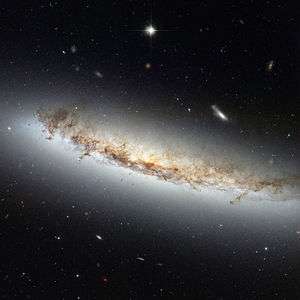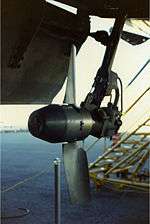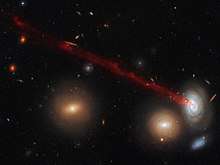Ram pressure
In physics, ram pressure is a pressure exerted on a body moving through a fluid medium, caused by relative bulk motion of the fluid rather than random thermal motion.[1] It causes a drag force to be exerted on the body. Ram pressure is given in tensor form as

,
where is the density of the fluid; this is the momentum flux per second in the direction through a surface with normal in the direction. are the components of the fluid velocity in these directions. The total Cauchy stress tensor is the sum of this ram pressure and the isotropic thermal pressure (in the absence of viscosity).
In the simple case when the relative velocity is normal to the surface, and momentum is fully transferred to the object, the ram pressure becomes
.
Derivation

The Eulerian form of the Cauchy momentum equation for a fluid is[1]
for isotropic pressure , where is fluid velocity, the fluid density, and the gravitational acceleration. The Eulerian rate of change of momentum in direction at a point is thus (using Einstein notation):
Substituting the conservation of mass, expressed as
,
this is equivalent to
using the product rule and the Kronecker delta . The first term in the brackets is the isotropic thermal pressure, and the second is the ram pressure.
In this context, ram pressure is momentum transfer by advection (flow of matter carrying momentum across a surface into a body). The mass per unit second flowing into a volume bounded by a surface is
and the momentum per second it carries into the body is
equal to the Ram pressure term. This discussion can be extended to 'drag' forces; if all matter incident upon a surface transfers all its momentum to the volume, this is equivalent (in terms of momentum transfer) to the matter entering the volume (the context above). On the other hand, if only velocity perpendicular to the surface is transferred, there are no shear forces, and the effective pressure on that surface increases by
,
where is the velocity component perpendicular to the surface.
Example - sea level ram air pressure
What is the sea level ram air pressure at 100 mph?
Imperial units
ρ = .0023769 sea level air density (slugs/ft3)
v2 = 1472 (100 mph = 147 ft/sec)
P = 0.5 * ρ * v2
P = 25.68 (pressure in lbf/ft2)
SI units
ρ = 1.2250 sea level air density (kg/m3)
v2 = 44.72 (100 mph = 44.7 m/s)
P = 0.5 * ρ * v2
P = 1224 (pressure in Pa = N/m2)
| Altitude (ft) | Air density (slugs/ft3) | Altitude (m) | Air density (kg/m3) |
|---|---|---|---|
| sea level | 0.0023769 | 0 | 1.2250 |
| 5000 | 0.0020482 | 1524 | 1.0556 |
| 10,000 | 0.0017555 | 3048 | 0.9047 |
| 20,000 | 0.0012673 | 6096 | 0.6531 |
| 50,000 | 0.0003817 | 15240 | 0.1967 |
| 100,000 | 0.0000331 | 30480 | 0.0171 |
Astrophysical examples of ram pressure
Galactic ram pressure stripping
Within astronomy and astrophysics, James E. Gunn and J. Richard Gott first suggested that galaxies in a galaxy cluster moving through a hot intracluster medium would experience a pressure of
where is the ram pressure, the intracluster gas density, and the speed of the galaxy relative to the medium.[4] This pressure can strip gas out of the galaxy where, essentially, the gas is gravitationally bound to the galaxy less strongly than the force from the intracluster medium 'wind' due to the ram pressure.[5][4] Evidence of this ram pressure stripping can be seen in the image of NGC 4402.[6]
Ram pressure stripping is thought to have profound effects on the evolution of galaxies. As galaxies fall toward the center of a cluster more and more of their gas is stripped out, including the cool, denser gas that is the source of continued star formation. Spiral galaxies that have fallen at least to the core of both the Virgo and Coma clusters have had their gas (neutral hydrogen) depleted in this way[7] and simulations suggest that this process can happen relatively quickly, with 100% depletion occurring in 100 million years[8] to a more gradual few billion years.[9]
Recent radio observation of carbon monoxide (CO) emission from three galaxies (NGC 4330, NGC 4402, and NGC 4522) in the Virgo cluster point to the molecular gas not being stripped but instead being compressed by the ram pressure. Increased Hα emission, a sign of star formation, corresponds to the compressed CO region, suggesting that star formation may be accelerated, at least temporarily, while ram pressure stripping of neutral hydrogen is ongoing.[10]
Ram pressure and atmospheric (re)entry
A meteoroid traveling supersonically through Earth's atmosphere produces a shock wave generated by the extremely rapid compression of air in front of the meteoroid. It is primarily this ram pressure (rather than friction) that heats the air that in turn heats the meteoroid as it flows around it.[11]
.jpg)
Harry Julian Allen and Alfred J. Eggers of NACA used an insight about ram pressure to propose the blunt-body concept: a large, blunt body entering the atmosphere creates a boundary layer of compressed air which serves as a buffer between the body surface and the compression-heated air. In other words, kinetic energy is converted into heated air via ram pressure, and that heated air is quickly moved away from object surface with minimal physical interaction, and hence minimal heating of the body. This was counter-intuitive at the time, when sharp, streamlined profiles were assumed to be better.[12][13] This blunt-body concept was used in e.g. Apollo-era capsules.
References
- Clarke, Cathie; Carswell, Bob (2007). Principles of astrophysical fluid dynamics. Cambridge University Press. p. 18. ISBN 978-0521853316.
- "Wading through water". www.spacetelescope.org. Retrieved 28 January 2019.
- Cramer, William J.; et al. (Jan 2019). "Spectacular Hubble Space Telescope Observations of the Coma Galaxy D100 and Star Formation in Its Ram Pressure–stripped Tail". The Astrophysical Journal. 870: 2. arXiv:1811.04916. doi:10.3847/1538-4357/aaefff.
- Gunn, James E.; Richard, J.; Gott, III (1972-08-01). "On the Infall of Matter Into Clusters of Galaxies and Some Effects on Their Evolution". The Astrophysical Journal. 176: 1. Bibcode:1972ApJ...176....1G. doi:10.1086/151605. ISSN 0004-637X.
- "Metal Enrichment Processes - S. Schindler & A. Diaferio". ned.ipac.caltech.edu. Retrieved 2017-02-25.
- "Ram Pressure Stripping | COSMOS". astronomy.swin.edu.au. Retrieved 2017-02-25.
- Sparke, L.; Gallagher, III, J. (2007). Galaxies in The Universe. Cambridge: University of Cambridge. pp. 295–296. ISBN 9780521671866.
- Quilis, Vicent; Moore, Ben; Bower, Richard (2000-06-01). "Gone with the Wind: The Origin of S0 Galaxies in Clusters" (Submitted manuscript). Science. 288 (5471): 1617–1620. arXiv:astro-ph/0006031. Bibcode:2000Sci...288.1617Q. doi:10.1126/science.288.5471.1617. ISSN 0036-8075.
- Balogh, Michael L.; Navarro, Julio F.; Morris, Simon L. (2000-09-01). "The Origin of Star Formation Gradients in Rich Galaxy Clusters". The Astrophysical Journal. 540 (1): 113–121. arXiv:astro-ph/0004078. Bibcode:2000ApJ...540..113B. doi:10.1086/309323. ISSN 0004-637X.
- Lee, Bumhyun; Chung, Aeree; Tonnesen, Stephanie; Kenney, Jeffrey D. P.; Wong, O. Ivy; Vollmer, B.; Petitpas, Glen R.; Crowl, Hugh H.; van Gorkom, Jacqueline (2017-04-01). "The effect of ram pressure on the molecular gas of galaxies: three case studies in the Virgo cluster". Monthly Notices of the Royal Astronomical Society. 466 (2): 1382–1398. arXiv:1701.02750. Bibcode:2017MNRAS.466.1382L. doi:10.1093/mnras/stw3162. ISSN 0035-8711.
- Lissauer, Jack J.; de Pater, Imke (2013). Fundamental Planetary Science: Physics, Chemistry and Habitability. New York, NY: Cambridge University Press. p. 293. ISBN 978-0-521-61855-7.
- Vincenti, Walter G. (2007). "H. Julian Allen: An Appreciation" (PDF). NASA Ames History Office. Retrieved 2017-03-06.
- Vincenti, Walter G.; Boyd, John W.; Bugos, Glenn E. (2007-01-01). "H. Julian Allen: An Appreciation". Annual Review of Fluid Mechanics. 39 (1): 1–17. Bibcode:2007AnRFM..39....1V. doi:10.1146/annurev.fluid.39.052506.084853.
